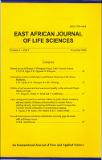Farm management practices and-their effects on yield, disease incidence and pest density of·banana and groundnut in western Kenya: planting density, intercropping and banana weevil Cosmopolites sordidus Germar (Gleoptera: Curculionidae) trapping

View/
Publication Date
2004-11-01Author
CKPO Ogol, PO Ogola, B Khayota, EM Njoka, GR Muraguri, CM Ndirangu, TE Akuja, E Zaady, D Ward, Y Gutterman, L Ngode, EW Kairu, JM Mueke, KV Seshu Reddy, AOK Adesehinwa
Metadata
Show full item recordAbstract/
Studies on the effects of pseudostem trapping, plant density and intercropping on the banana
weevil Cosmopolites sordidus Germar. populations and crop yields were conducted in
western Kenya from 1994 to 1997. The objective of the investigation was to explore the
efficacy of non-pesticidal options for the management of banana weevil. Field experiments
were conducted using clean planting material, pseudostem traps for weevil management and
intercropping banana with groundnuts, Arachis hypogaea L. in two different banana densities.
Results indicate that at low weevil population density, pseudostem traps significantly reduced
the number of adult weevils. It suppressed weevil population increase and reduced the level of
damage caused to the crop. Though intercropping banana with groundnuts did not prevent
weevils from colonizing the banana, it influenced their distribution during the early growth
stages of the banana. Banana crops planted at 3x 3 m and 5x 5 m spacing did not affect the
growth of groundnuts during the first year. However, beyond this period, the banana canopy
significantly reduced the growth oftlle groundnuts, which were intercropped within the 3x5
m banana spacing. \Nevertheless, spacing significantly influenced the banana yield per unit
area. Thus under the 3x3 m banana spacing, yields were more comparable with the 5x5 m
banana spacing. Competition for growth factors was first experienced in the banana at 3x3 m
under the groundnut intercrop after three gr.~ing seasons. The number of flower thrips,
aphids, and groundnut rosette virus were relatively reduced in the banana intercrop compared
to those in the groundnut monocrop.
Collections
- Department of Zoology [161]
